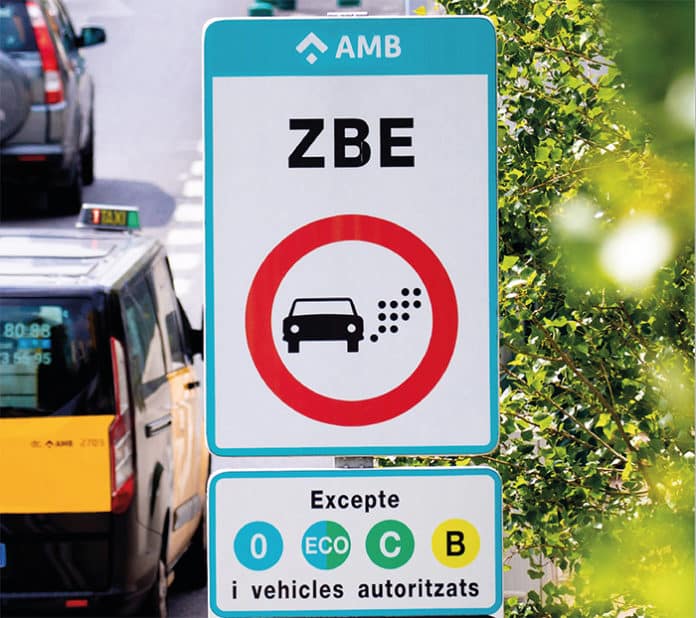Municipalities with more than 50,000 inhabitants, island territories and municipalities with more than 20,000 inhabitants that exceed the limit values of regulated pollutants will adopt sustainable urban mobility plans before 2023 that introduce mitigation measures that allow the reduction of mobility emissions, including, among others, the establishment of low emission zones
The Council of Ministers has approved the proposal of the Ministry for the Ecological Transition and the Demographic Challenge (MITECO), the royal decree that regulates the Low Emission Zones (ZBE). Spanish municipalities with more than 50,000 inhabitants, island territories and municipalities with more than 20,000 inhabitants that exceed the limit values for regulated pollutants must adopt sustainable urban mobility plans before 2023 that introduce mitigation measures that make it possible to reduce emissions derived from mobility, including, among others, the establishment of low emission zones.
For this reason, MITECO developed, with the collaboration of the Spanish Federation of Municipalities and Provinces (FEMP), Guidelines for the creation of ZBEs, so that Local Entities could use them as a guide to design and implement these areas. These Guidelines were presented on November 19, 2021.
In accordance with the provisions of article 14.3 of the Climate Change and Energy Transition Law, which includes the establishment of these zones, ZBE is understood to be the area delimited by a public Administration, in exercise of its powers, within its territory, of a continuous nature, and in which restrictions on access, circulation and parking of vehicles are applied to improve air quality and mitigate greenhouse gas emissions, according to the classification of vehicles by their level of emissions in accordance with what is established in the current General Vehicle Regulations.
The development of the royal decree approved today defines specific and quantifiable objectives in the field of low emission zones, which can be conveniently monitored and evaluated, and establishes the minimum requirements that these zones must meet in key aspects such as extension, delimitation or access conditions, providing legal certainty to individuals and companies through homogeneous legislation throughout the national territory.
KEY ASPECTS OF THE ROYAL DECREE
The LEZs must contribute to improving air quality and mitigate climate change and it will be ensured that the measures associated with the fulfilment of these purposes promote compliance with the acoustic quality objectives, the promotion of modal change and the promotion of energy efficiency in the use of means of transport. All this will result in an improvement in the health of citizens and the quality of urban life, promoting more sustainable and inclusive mobility with less impact on the quality of the sound environment, and promoting active mobility and the recovery of public space.
Regarding the air quality objectives, ZBE projects must lead to an improvement with respect to the starting situation, and, in any case, ensure compliance with the legislated values. In addition, the royal decree aims, as its ultimate goal, at complying with the updated version of the WHO Guidelines on air quality, published in 2021, which, based on available scientific knowledge, includes the recommended air quality levels for the protection of public health.
With regard to the climate change mitigation objectives, local entities must define measurable and quantifiable objectives for 2030 for the reduction of greenhouse gas emissions in the LEZs, in a manner consistent with the objectives established in the PNIEC, in particular, with the objective of reducing the use of private motorized vehicles compared to other modes of transport.
As long as compliance with the aforementioned objectives is guaranteed, the regulation allows exceptional access for polluting vehicles for justified reasons, such as vehicles with which basic public services are provided, among others, emergency services or garbage collection.
The rule also provides for the need for permanent coordination and cooperation between administrations, especially in island territories, metropolitan areas and in response to the urban distribution of goods. Likewise, it includes the need to facilitate participation measures of the different social agents and to signalize the low emission zones.
The royal decree also establishes that local entities facilitate the installation of recharging points or the supply of clean fuels such as hydrogen and can introduce complementary measures within the building sector, measures for the replacement of heating systems, efficient energy rehabilitation and promotion emission-free air conditioning systems. In the same way, interventions in urban areas of an adaptive nature may be incorporated, such as those aimed at mitigating the heat island effect or increasing urban green areas with adapted species.
Finally, the applicable penalty regime is provided, referring to traffic regulations for these purposes and a transitional period of four years for adaptation to the new standard of LEZ projects established prior to its entry into force.
PUBLIC PARTICIPATION
The text of the royal decree has been submitted to public participation between April 21 and May 13, 2022. Comments and proposals have been received from 157 individuals, associations, companies and public entities. It has also been submitted to the hearing process to autonomous communities, local entities and representative entities of affected sectors, from April 26 to May 17, 2022. And the reports of the concerned ministries have been collected.
The post The Government approves the royal decree that regulates Low Emission Zones first appeared on N332.es – Driving In Spain.





